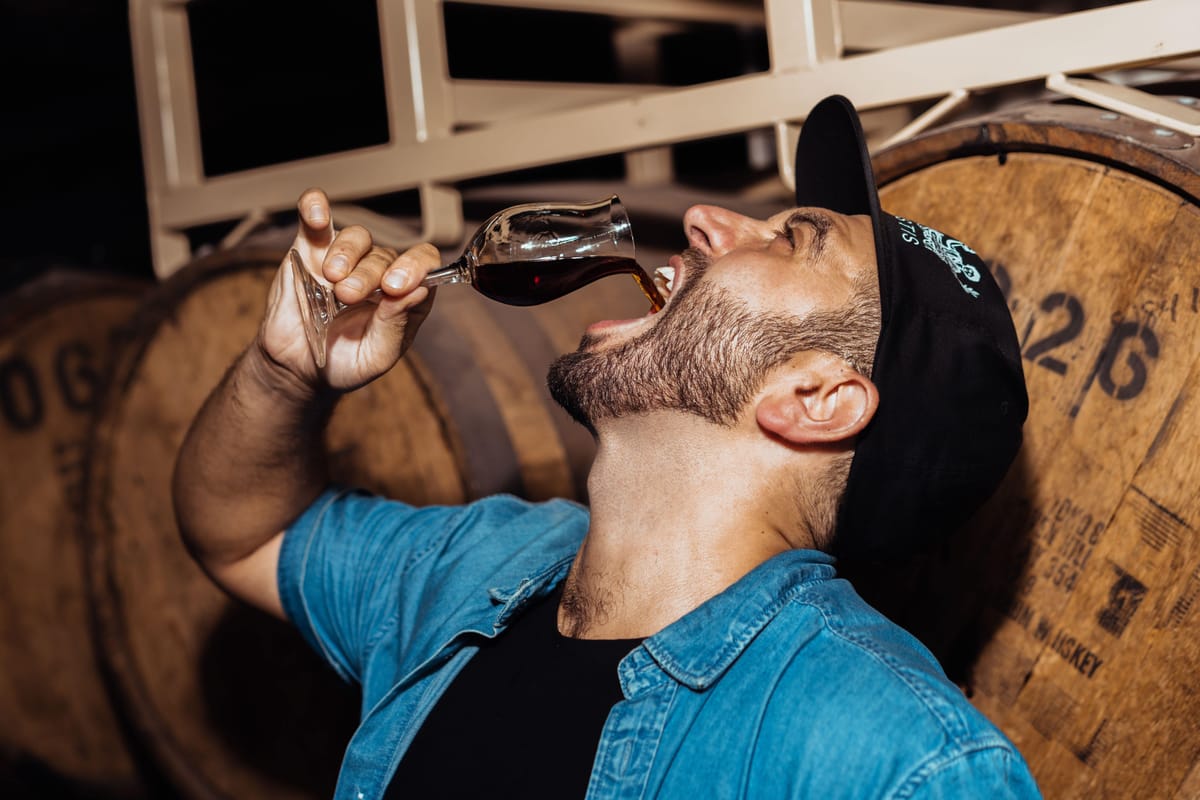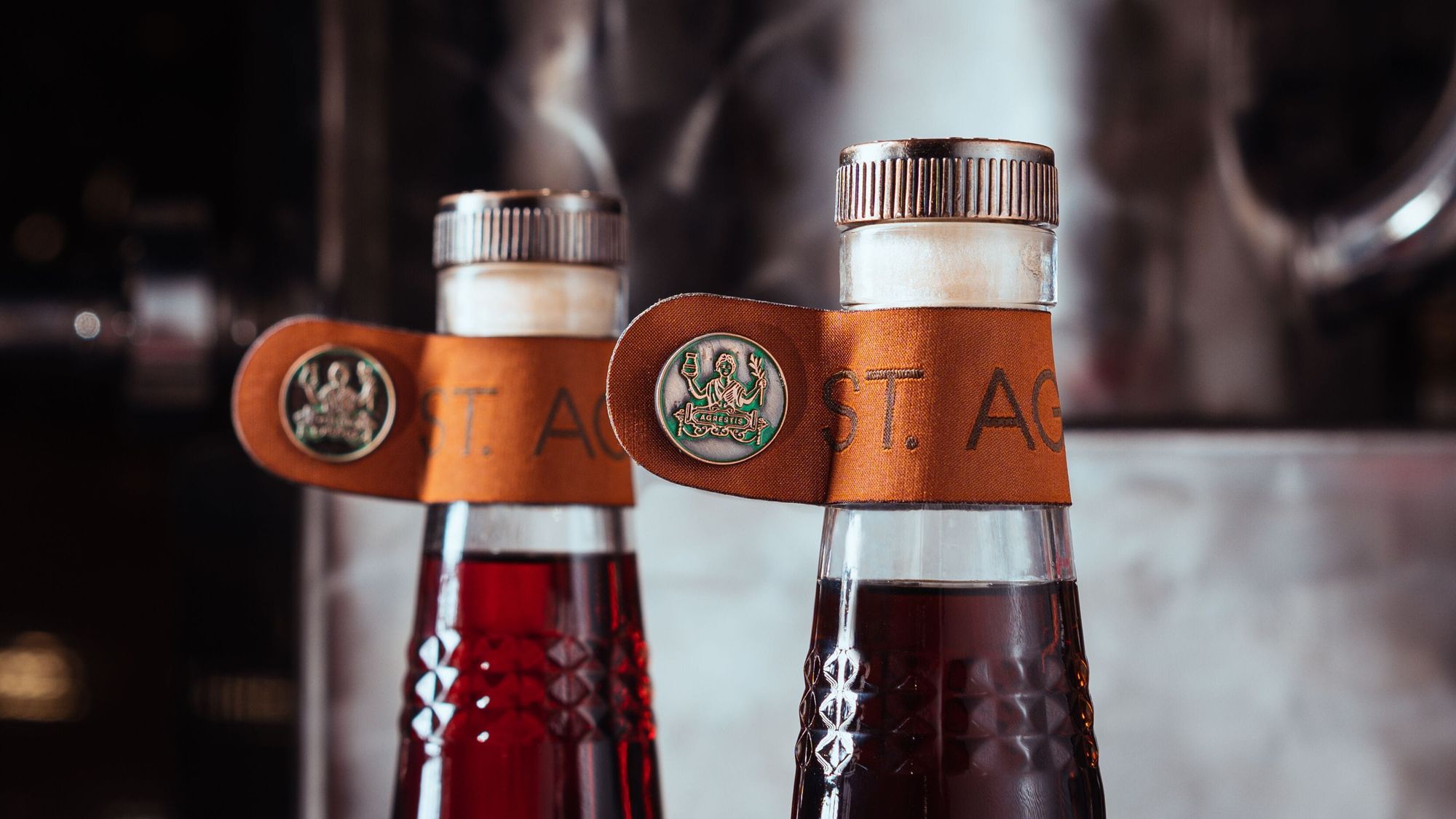For Negroni Lovers: Greenpoint Welcomes New Amaro Taproom St. Agrestis


GREENPOINT — A Greenpoint-based brand of Italian-inspired liqueurs and pre-bottled cocktails, St. Agrestis, with a following among Brooklyn’s bitter cocktail crowd, opened its new taproom this month for tours on weekend afternoons at 233 Eagle Street.
The taproom is buried inside a Greenpoint warehouse, where St. Agrestis cooks up their Italian-style aperitivos alongside their neighbors, Greenhook Ginsmiths. The warehouse was rented in 2010, and the gin distillery launched in 2012 by Steven DeAngelo, a former Wall Street broker who runs the gin distillery with his brother and, since 2017, it has also been the home of St. Agrestis, the liqueur brand DeAngelo co-owns with Louis Catizone.
A single, thick-rimmed table centers the scene and the voluminous ceiling above seems to open up to the sky itself. The walls are painted an industrial white and the minimally decorated and windowless room, cavernously located in the warehouse’s center.
A playlist of Mac Demarco and old school hip-hop rattles on the walls and the ten or so people inside drink negronis that are the rich, deep color of redwood forests. The drink is one of two that St. Agrestis specializes in: it combines the gin made in the next room with a house-made vermouth and a botanical bitter liqueur simply called Inferno.
The latter is one of St. Agrestis’ original creations and is also sold on its own in a tall bottle shaped like a sleek laboratory vial and stamped with the crest of the brand’s fictional saint, who balances an herb in one hand and a mysterious elixir in the other.
“[Agrestis] is Latin and means ‘of the wild’ or ‘of the earth,’” Catizone tells Bklyner of the company’s name, “I like the phrase because it’s something only someone in the city would observe about someone.”
The name and idea originally belonged to two Gowanus sommeliers who discovered an affection for Italian digestifs while traveling in Italy. After discovering how competitive the amaro business was, they sold the idea to Catizone, an excitable and energetic Italian-American who grew up in New Jersey, with a father from Italy and a mother who grew up around Saint Cecilia’s Catholic Church in Greenpoint.

Bitter after-dinner cocktails had been a cultural curio in his youth but suddenly Catizone saw the world taking notice.
“All of a sudden all my friends were drinking negronis with me,” he says of one drink’s recent renaissance; in 2018, Drinks International had declared negronis the second most-asked for cocktail in the world, a notch below the old-fashioned cocktail.
Catizone had only just gotten into the professional drinking world — he had abandoned his career as a Phillip Morris salesman in 2014 — when a stranger interrupted his gin & tonic on vacation in the Virgin Islands and implored him to try a then-new gin line by a Greenpoint-based outfit called Greenhook Ginsmiths.
“I tried it and I was floored by it,” Catizone said he immediately wanted to get their brand inside liquor stores around the country. After spending some time marketing DeAngelo’s gin brand, Catizone convinced him to invest in developing a line of Italian spirits, starting with the amaro recipe he had just bought from the Gowanus sommeliers.
And after trying the amaro recipe and tweaking it–notably, making it less sweet–DeAngelo was ready to take on his competitors in the business.
Montenegro, DeAngelo says, is an entry-level amaro, which is one of the more popular brands of Italian amaro being used by today’s savvy spritz mixers. Fernet-Branca–the mysterious century-old drink that took over cocktail culture in the mid 2010s–paved the way for herbal liquors and bitter digestifs, the owners agree.
DeAngelo admits that he’s discovered Italian-style herbal liqueurs to be a competitive business, a vicious battleground for the same affluent buyers who’ve tried them all.
A firm, tough-talking New Yorker, DeAngelo says he grew depressed after the collapse of Lehman Brothers in 2008, so he left the business and invested in developing a distillery, which he opened with his brother in 2012.
Like his style, DeAngelo’s approach to gin is minimal, and his distillery is a gleaming maze of silver-colored tubes, decorated with the occasional medieval print.
“[Gins] started to taste like flavored vodkas,” he told us. “Our approach was to make a gin that wasn’t.”
The same approach can be said of St. Agrestis’ take on the popular spritz aperitivo, which self-consciously avoids the saccharine Capri Sun affect that food writer Rebekah Peppler had notably bemoaned of today’s popular Aperol spritzes.St. Agrestis’ take on the aperitivo spritz, which combines a dark, heady aperitivo with white wine, comes in miniature bottles. The negronis, which are made with DeAngelo’s next door gin, have proven, unsurprisingly, even more popular. A notice in the New York Times calls it “a smooth, balanced drink.”
“American culture is being much more bitter,” Catizone says, citing the increased popularity of kale, dark chocolate, and IPAs among today’s urban sophisticates.
Which may be what the people want. Catizone says St. Agrestis will start selling their spritzes and negronis by the can come summer.
St. Agrestis’ taproom is open Saturdays and Sundays from 1pm-6pm.
Update: the article has been updated to reflect that their warehouse was rented in 2010, not bought, and the gin distillery launched in 2012, not 2013; that Catizone is from New Jersey, not Brooklyn; clarified that their aperitivo spritz is not an Aperol spritz.




